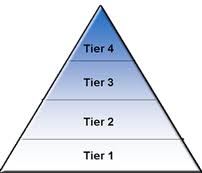If anyone want to get a web page on the internet then they have to choose a suitable web hosting provider. There are many web hosting providers in the web hosting market with their different hosting plans, like- shared hosting, reseller hosting, vps hosting, dedicated hosting, cloud server hosting etc. Users have to choose the web hosting plan based on how they plan to utilize their website, how much budget they have for the server, and how much time they want to spend maintaining the servers which make up the website.
Select a perfect hosting service is very important for online business. So, business owners have to careful about hosting service selection. The most important point before selecting web hosting service is reliability of the data center. It would be better if the business owners get a clear idea about different levels of classification based on the ANSI/TIA-942 Telecommunications Infrastructure Standard for Data Centers.

Tier I : The tier I data centers are same as a normal computer rooms. Users have to shutdown the machines for which require a preventative maintenance. So, users get 99.671% uptime and 28.8 hours downtime Per Year with it. Users get don’t pay IP transit, means, the users don’t have a global presence and don’t pay another providers for any kind of connectivity. Finally we can say about Tier I is that, it would be suitable for small business.
Tier II : The tier II data centers are facilities have some redundancy even so have a single path for power. Users have to shutdown the machines for which require a preventative maintenance. So, users get 99.749% Uptime and 22 Hours downtime per year with it. In this case networks have a national or international footprint, however pay IP transit to reach some portions of the Internet. Finally we can say about Tier II is that, it would be suitable for medium size businesses.
Tier III : The tier III data centers have enough redundancy even though they have a single path for power and it permit the maintenance without downtime (N+1 redundancy.) Tier III data centers are required to have minimum 13.2 KV (kilo volts) of power. So, users get 99.982% uptime and 95 minutes downtime per year and 72 hour power outage protection with it. In this case networks are regional providers. Big data centers have tier III networks and build redundancy through redundant POPs (points of presence) outside of their facilities. Past the POPs, these providers pay for IP transit. Finally we can say about Tier III is that, it would be suitable for Large Businesses.
Tier IV: Maximum Tier IV data centers have their own internal network but they pay other networks for IP transit outside of the facility. Tier IV data centers are the top tier. They are built with multiple paths to power and AC and are designed to cope with a worst-case scenario with no critical impact. Tier III data centers are required to have minimum 26.2 KV (kilo volts) of power. So, users get 99.995% Uptime and 26 minutes downtime per year and 96 hour power outage protection with it. In this case networks are regional providers. Finally we can say about Tier III is that, it would be suitable for Enterprise Corporations .